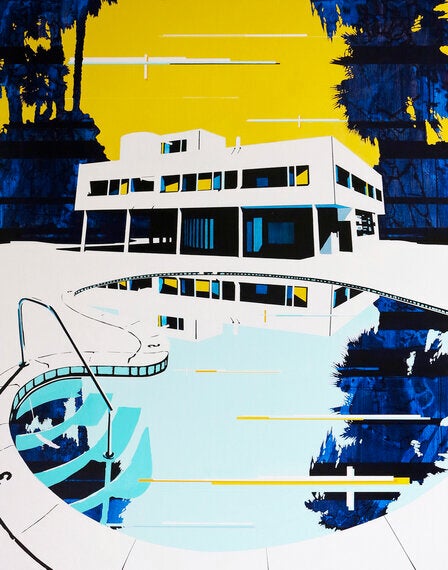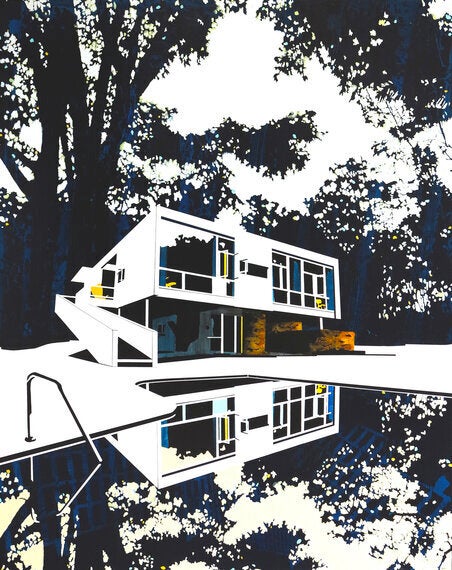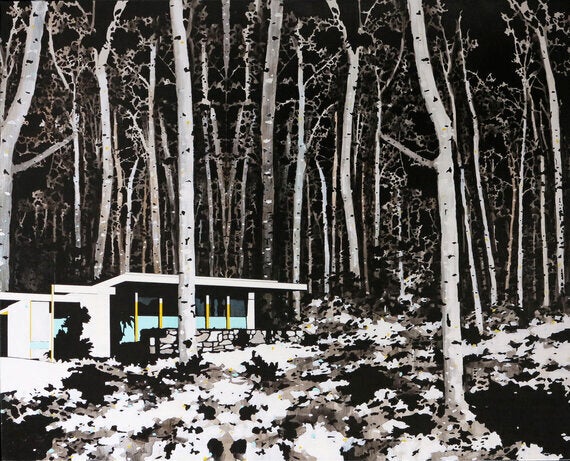
All Images © Paul Davies, 2014
Australian artist Paul Davies first caught my eye earlier this year, with his atmospheric series of paintings which seductively draw you into a utopia that precariously balances between an unforgiving natural space and a built urban environment.
Inspired by American and Australian modernist architecture, his work features fictitious 60s-style architectually conceived houses, often displaced in wild wooded locations, set with an injection of washed out or faded colours. Using hand cut stencils, he juxtaposes, repeats and mirrors subjects, blurring the narrative, yet all pieces follow one core signature - they are missing a human connection within, each home vacant - the only connection being the viewer's eye drawn to inhabit the space they see before them, evoking a feeling of serenity, clarity and a kind of lonely openness.
His latest exhibition, "Built In Translation", is currently on show at London's Fine Art Society Contemporary, which runs until April 24th 2014.
I met with the artist to discuss how it all began with a simple Asterix drawing.

When did you know you wanted to be an artist?
Since I was a kid I always liked drawing and after my Dad saw some sketches I made of the cartoon character Asterix, he and my Mum found a local artist who took art classes. At first Kel [his teacher] refused to take me because I was only 7 years old, but my Mum insisted and said that drawing was all I was interested in. I ended up going to classes with him for the next 8 years. We still write to each other, which is great. He [Kel] taught me the basics of oil painting, mostly landscapes.
Then in high school my parents bought a painting by Australian artist Jeffrey Smart, the work is typical of his suburban themed style, which I really loved for its geometric precision. It inspired me to make paintings based on suburban subjects that were around me.
How did that progress into a career?
Art was a way to make friends who were into the same things; I drew logos of the bands I was into like Metallica, which was fun to share with other kids at school. However I never thought it would be possible to make a living from art. It wasn't until I joined a group studio in Sydney and met other artists - graffiti artists, street artists, graphic designers and fashion designers, that I realised it could happen.
There's a running architectural vs. environmental theme in your work, why is that key to your aesthetic?
I'm attracted to the contrast between the two, the idea that the built environment is a response to, or an attempt to control the natural. The buildings I paint may seem nostalgic due to the style of architecture and palette, but these subjects are abandoned, which for me implies that the picture is no longer just about a previous "golden age" but a sense of now and posing a question of what happens next.
So how did the creative process of stenciling evolve with your vision?
Initially I was attracted to stenciling because of its immediacy and contrast. I learnt stenciling techniques through watching friends stencil walls and canvases and over time my stencils became more detailed. I also switched from using spray paint to brush and acrylic as I could create deeper layers through colour washes and fades.
I prefer to hand cut the stencils rather than laser cut as it allows me to make the decision of what remains and what is removed, it's similar to drawing. It's also a medative process, which I like because I get ideas for other work while I'm cutting them.
The stencil has a physical unchanging memory and acts like a skeleton to the painting.
You mention other ideas that come to you when you're working, what outside influences inspire you?
I always play music in my studio while painting. Music is not a direct reference for my work but I like the way it can enhance or change your mood while making it. I love artists like Kurt Vile and The War on Drugs, but also bands like The Beastie Boys when I'm struggling to get motivated on Monday morning. [laughs] I also love being outdoors, which comes from being a kid and not having a TV in the house till I was about 15. I swam a lot and that memory of staring at the washed out pastel colours of pool floors and tiles influenced part of my painting pallet.

I feel that colour helps to bring your work to life, but there always seems to be an absence of any human life, why is that?
The absence of the human form is to invite the viewers to respond with their own interpretation. If a person was present in the picture the viewer might be more concerned about that figure than the environment in which they appear. I think it's more interesting to omit the human form and allow the viewer to generate possible scenarios, that way it can mean something different each time. I also like the way the empty houses are reflected in the full swimming pools, much like a mirror, and done in a way to say: "is the viewer also being watched?"
That's slightly creepy! And now I'm thinking what would happen if you painted one solitary figure in a window, just staring out, that would change the mood of the piece entirely. Although the houses are aesthetically pleasing, they appear quite uninviting. What's the narrative there??
The scenes and structures seem picturesque, but in reality these iconic homes can often feel austere and isolated. I really like wandering around places like that on my own and the paintings are an attempt to translate that sense of isolation. I've also attempted to explore the concept of isolation by incorporating empty swimming pools in the pictures - during school I swam and was always struck by the vacant feeling of the outdoor pools when they were drained for winter.
It's that eerie feeling of something that once had life and is now just an urban emptiness. So in that sense, we all interpret paintings in our own way - what ideally do you want the viewer to take away from your work?
I hope that the paintings remind the viewer of a place they have been to, but due to the work being a collage or utopia of different locations, the viewer is invited to create their own scenario.
You're quite experimental in your vision and methods, so how do you see your work evolving in the future?
Painting will always remain at the core of my work, however the stencil has provided a way to flesh out my process, to observe positive and negative space, which has developed into sculptures for example. I hope to experiment more with lighting the sculptures and creating site-specific installations.
And do you think living in LA with its eclectic mix of artists will help influence your creativity? [Paul was previously based in Sydney for 9 years].
Sydney was an inspiring place to create work because we all came from different backgrounds and would often bounce ideas off one another.
Los Angeles for me is more of a destination city and has a very interesting mix of architecture, which is really inspiring for me. I like that it also has suburbs where you travel to see specific things, for example Culver City with all the new gallery spaces opening up. The artists I've met in LA are all doing really interesting things and that buzz rubs off on me.
And talking of other artists, who else inspires you?
The late Australian artist Howard Arkley is one of my favorites. His work at the Australian pavilion at the 1999 Venice Biennale was in part a response to the way Australian culture adopts European and American themes to create its own, this was done using stencils and bright colours which has influenced my work.
I really admire [British artist] Rachel Whiteread, turning the empty space of an interior into a physical sculpture is such a simple way to think of the spaces we inhabit. In a way I am trying to look at a similar idea through the positive and negative spaces of stencil.
I also love Peter Doig's work, it is beautifully painted and I feel like the viewer can walk right into the large-scale works.
For more information on Paul Davies, visit his website www.pauldavies.com.au